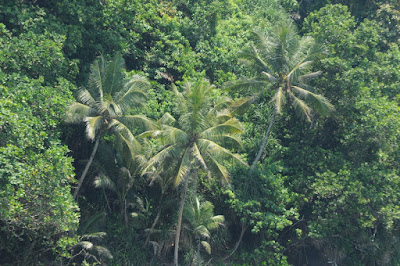From the Salak estuary we took a break from dolphin-watching (see previous post), heading over the waves for a tiny pile of rocks in the South China Sea. According to the blog Dolphins of Sarawak, Pulau Tukong Ara "was gazetted as a wildlife sanctuary in 1985 but later incorporated into the Talang-Satang National Park when this was created in 1999. The reason why the rock is protected is because it is inhabited by a breeding colony of Bridled Terns and Black-naped Terns."
Signboards (now long faded) identify the islet as a protected area.
Signboards (now long faded) identify the islet as a protected area.
The Bridled Tern (Onychoprion
anaethetus) is found pretty much around the world in tropical waters; I saw
my first one half a world away (and over half a century ago), in Jamaica. It is one of the most pelagic of terns, ranging well out to sea after the breeding season.
Bridled Terns differ from another widespread pelagic species, the Sooty Tern (Onychoprion fuscatus) in having browner backs and a narrow white line over the eye and bill rather than a larger white wedge.
Although its range is not as global as that of the Bridled Tern, the Black-naped Tern (Sterna sumatrana) still occurs over a vast area of the Indian and Pacific Oceans, from the Seychelles to southern Japan and northeastern Australia. To my mind it is one of the prettiest and most graceful of all terns. It is pretty much strictly a bird of coasts, reefs and small islands.
Here are a few shots of a greeting ceremony between members of a pair, after one of them alights. A lot of bill-lifting, bowing etc.!
The other obvious bird we could see as we circled the island was the Pacific Reef Heron (Egretta sacra). Reef Herons come in two colour forms, white and dark, but the birds we saw were all in the dark phase (notice the white throat). The refuge signs provided them with a useful lookout point.
Before heading back to the estuary, we dropped in for a look at one of the two Satang Islands (I'm afraid I'm not sure which). We did not land (most visitors come to swim off the sandy beach).
The Satngs are covered with forest, and I could hear the sounds of birds as we sailed past. Once I glimpsed the white shape of a Pied Imperial Pigeon (Ducula bicolor) flying over the ridge - Pied Imperial Pigeons, birds that nest on small offshore islets and fly, if need be, to other islands or the mainland in search of fruit, are specialties of places like this.
So is a very similar but much rarer bird, the Silvery Wood Pigeon (Columba argentina), that once flew with the Pied Imperial Pigeon but is now, for some unknown reason, all but extinct. They lived on islands near here years ago, and our friend Kerry-Jayne Wilson (who ought to know) swears she saw one on nearby Talang Talang about a decade ago; could there still be a few, somewhere, off the coast of Sarawak?


























No comments:
Post a Comment